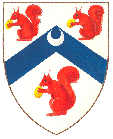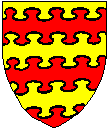
Sir Thomas LOVELL of Enfield
Born: 1453
Died: 25 May 1524
Buried: Prob. monastery of Haliwell, Shoreditch, London
Notes: Knight of the Garter.
Father: Ralph LOVELL of Barton Bendish (Sir)
Mother: Anne TOPPEMarried 1:
Eleanor RADCLIFFEMarried 2: Isabel ROS

The details in this biography come from the History of Parliament, a biographical dictionary of Members of the House of Commons.
Treasurer, L. Inn 1472-5, autumn reader 1475, gov. 1475-6, 1479-80, 1481-2. J.p. Norf. 1478-81, 1485-d., Mdx. 1491- d., Oxon. 1493-1515, Notts. 1493-1514, midland counties 1493, Staffs. 1493, 1508-d., Berks. 1495-d., Surr. 1505-d., esquire of the body 1485, knight 1487; Councillor 1485; treasurer of the chamber 1485-Aug 1492, of the Household Aug 1492-24 Apr 1522; Speaker of House of Commons 1485; chancellor of the Exchequer 12 Oct 1485-28 May 1516; constable, Wallingford castle (with Sir William Stonor) Nottingham castle 1489, the Tower 1513; warden and c.j. in eyre, Sherwood forest 1489, this side of the Trent, 1510; jt. (with James Hobart) steward, duchy of Lancaster, Cambs., Norf., and Suff., 1489-1518; commr. array Norf. 1490, Notts. 1511, midland counties 1513, subsidy Bucks. 1512, Mdx. 1512, 1514, 1515, 1523, Norf. 1515, 1523, Household 1514, 1515, enclosures Mdx. 1517; apprentice-at-law retained by duchy of Lancaster by 1498; high steward, universities of Oxford and Cambridge 1509; marshal of the Household 1512-13; master of wards 14 June 1513-18, jt. (with Richard Weston) Jan. 1518-Dec. 1520; lt. of Calais temp. Henry VIII.
A fifth son of Sir Ralph Lovell of Barton Bendish, he made a career for himself at the royal court. Joined Henry Tudor as an esquire during his exile in France. He fought at Bosworth (1485), when Henry landed on the south coast with a couple of thousand French mercenaries and a few Lancastrian knights, gathering more support on their way north. Richard III was slain, and the battle was ended amidst Yorkist treachery and desertion. Lovell also fought at the battle of Stoke in 1487, when the pretender Lambert Simnel, already crowned King of England in Dublin by his supporters, was finally routed, and the Tudor dynasty was safely assured. Lambert Simnel is said to have attended Sir Thomas's funeral in 1525, as he was the last survivor of Stoke, although they fought on opposite sides. Lovell was knighted by Henry VII for his prowess. His elder brother Sir Gregory was made banneret at Stoke as well.
He entered Parliament as M.P.. for Northamptonshire in 1485, presumably with a great reputation already, for he became Speaker of the House of Commons from 1485-88. He was still a plain esquire, not being knighted until 1487. In 1485 he was also appointed Chancellor of the Exchequer for life, with an annuity. Sir Thomas was made Knight of the Garter in 1498. Henry preferred to use the Garter to reward his closest associates and advisors, creating 37 new Garter Knights.
The Milanese Ambassador commented in 1497 that Reginald Bray, Giles Daubeney (later the King's Chamberlain), John Morton, Bishop of Ely, and Lovell were the leading men in the realm, an opinion backed by Venice and by the Spanish envoy. Later he had many court appointments - among them as President of the Council in 1502, and Constable of the Tower in 1509. During his lifetime he was one of the most powerful men in the country, a confidant of and advisor to the King. Had custody of Edmund lord Ros' lands during latter's incapacity. Lovell was constable of the Tower from 1509 on and one of the leaders of the army that marched north to defend England from Scottish invaders in 1513. He retired from court in 1516.
At the accession of Henry VIII, Sir Thomas Lovell was able to look back on a distinguished career in the service of the first Tudor monarch, one of whose firmest supporters he had been. The young King, who to please his subjects dismissed several of his father’s advisers, confirmed Lovell in all his offices despite his unpopularity with some and rewarded him with two important posts, the constableship of the Tower and the mastership of wards: thus assured he continued to be one of the most respected and influential men in the realm.
During the absence abroad of George Talbot, 4th Earl of Shrewsbury he was entrusted with the marshalcy of the royal household, and in 1513 he remained in England to guide Catalina of Aragon in her regency while the King and most of his Council went to France. A year later he did briefly visit Calais (unless it was his nephew, knighted at Tournai, who did so), for which as lieutenant he was responsible. He disagreed with the policies favoured by the King’s ascendant minister Wolsey, and in 1516 the Venetian ambassador reported his temporary withdrawal from court when he lost his chancellorship, and the resignation of several of his most intimate colleagues. Lovell was never to recover his former position on the Council, perhaps because he was growing old and infirm and now preferred retirement: certainly he played a role of decreasing importance, executing the posts which he retained only through joint appointments or deputies, and making it clear that he had no intention of sitting on the many commissions to which he was named.
Presumably Lovell was elected to the first four Parliaments of Henry VIII, although in the absence of the returns his Membership is known only for that of 1510 when he and several associates (who were not named) received the ‘Subsidy Act’ at the bar of the Upper House. He had probably been elected on this occasion (as he had been at least once before) for Middlesex, where his marriage to the sister and eventual coheir of the 10th Lord Ros, and his occupation of the Ros mansion at Enfield, made him one of the more important figures. A letter dated 14 May 1523, about events in the Parliament then sitting at the Blackfriars, ends with a report that he, Henry Marney, 1st Baron Marney, and Sir Nicholas Vaux, 1st Lord Vaux, were ‘right sick’; notwithstanding his age and Wolsey’s coolness towards him, he evidently still counted in public estimation.
He built the gatehouse at Lincoln's Inn, placing his own and Henry VIII's arms on it; and also built East Harling manor, with his arms on that. He endowed a nunnery at Halliwell, near Enfield, and he was buried there in 1524 with his wife, Isabel, daughter and co-heiress of Lord Roos of Hamlake. His heir was Gregory's second son Sir Francis Lovell.
Lovell survived both Marney and Vaux to die in the following year on 25 May at Elsing. In his will, dated 10 Dec 1522, directing that he should be buried in the chapel which he had built in Holywell priory, Shoreditch, he lists: his cousin Chamberlian's daughter, married to John Dethick; his brother Sir Robert Lovell; William Hussey m. to a daughter of said Robert Lovell; John Fitz-Lewis m. to a daughter of said Robert Lovell; Anthony Gourney m. to a daughter of said Robert Lovell; John Billesby m. to a daughter of said Robert Lovell; Thomas Manners now lord Roos [his nephew by marriage]; Oliver Manners brother to said lord Roos; Richard Manners brother to said Oliver; his cousin Francis Lovell; his cousin Sir Thomas Lovell; Edward Lovell brother of Francis Lovell, Francis Goodere and Richard Whalley.
His heir was his nephew (called ‘cousin’ in the will) Francis Lovell, father of Sir Thomas Lovell. His bust in profile was cast by the Italian sculptor, Torrigiano.
Sources:
Hawkyard, A. D.K. : LOVELL, Sir Thomas I (by 1450-1524), of East Harling, Norf. and Elsing by Enfield, Mdx
 to Bios Page
to Bios Page |
 to Family Page
to Family Page |
 to Peerage Page
to Peerage Page |
 to Home Page
to Home Page |